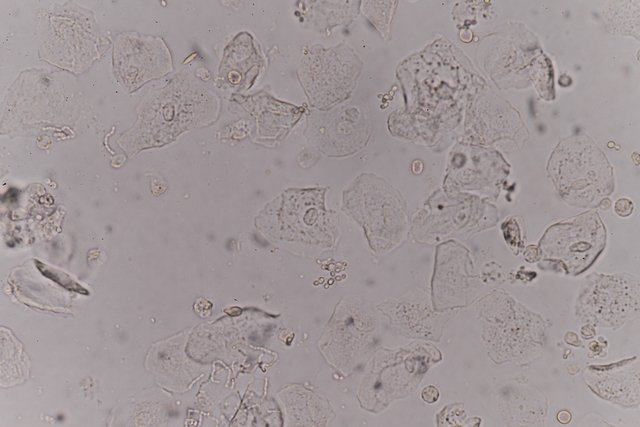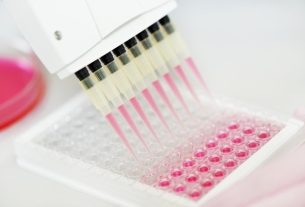The presence of epithelial cells in urine is considered normal and generally has no clinical relevance, as it indicates that there has been natural desquamation of the urinary tract, causing these cells to be eliminated in the urine. However, epithelial cells in urine can also be a sign of urinary infection, kidney changes or indicate contamination of the sample at the time of collection.
Despite being considered a normal finding, it is important that the number of epithelial cells found and whether any changes in the nucleus or its shape were observed during the examination, as these may indicate more serious situations.
It is important that the result of the exam is evaluated by the doctor so that the cause of the change can be identified and, therefore, the most appropriate treatment can be initiated, if necessary.

Main causes
The main causes of epithelial cells appearing in urine are:
1. Contamination of the urine sample
The main cause of a greater quantity of epithelial cells in urine is contamination that can occur at the time of collection, which is more common in women. To confirm that it is contamination and not an infection, for example, the doctor must evaluate all the parameters analyzed in the exam. Normally, when it comes to contamination, the presence of epithelial cells and bacteria can be observed, but rare leukocytes in the urine.
To avoid contamination of the sample, it is recommended to clean the intimate area, discard the first stream of urine to eliminate impurities from the urethra, collect the rest of the urine and take it to the laboratory to be analyzed within a maximum of 60 minutes.
2. Urinary infections
In urinary infections, it is possible to observe on examination the presence of some or numerous epithelial cells, in addition to the presence of microorganisms and, in some cases, the presence of mucus filaments. Furthermore, in the case of a urinary tract infection, an increased amount of leukocytes may be observed in the urine.
Learn about other causes of leukocytes in urine.
3. Menopause
Women who are in the postmenopausal phase and who have a low amount of circulating estrogen may also have greater amounts of epithelial cells in their urine.
Despite this, it does not pose a risk to the woman nor does it cause symptoms. However, it is important to go to the gynecologist so that hormone levels can be assessed and, if necessary, hormone replacement treatment can be started.
4. Kidney problems
When numerous tubular epithelial cells and epithelial casts are seen, it indicates kidney problems, as this type of epithelial cell has renal origin. The greater the number of tubular epithelial cells, the greater the degree of damage to the kidneys and the greater the chance of loss of the organ’s functionality.
Normally, in addition to changes in the type 1 urine test, changes can be seen in biochemical urine tests, such as urea and creatinine, for example, indicating that there is damage to the kidneys.
How to understand the result
In urinalysis, the presence or absence of epithelial cells is given as:
- Rarewhen up to 3 epithelial cells are found per field analyzed under the microscope;
- Somewhen between 4 and 10 epithelial cells are observed;
- Numerouswhen more than 10 epithelial cells are seen per field.
As most of the time the presence of epithelial cells in urine has no clinical relevance, it is important that the quantity of cells is interpreted together with the results of other parameters observed, such as the presence of mucus filaments, microorganisms, cylinders and crystals, for example. . Understand how the urine test is done and what it is for.
Do you have questions about your exam results?
Epithelial cells can be classified according to their place of origin into:
- Squamous epithelial cellswhich are the largest epithelial cells, are more easily found in urine, as they originate in the vagina and female and male urethra, and are normally related to sample contamination;
- Transitional epithelial cellswhich are epithelial cells present in the bladder and when found in large quantities can be indicative of urinary infection, especially if, in addition to epithelial cells, a large number of leukocytes are observed;
- Tubular epithelial cellswhich are cells found in the kidney tubules and can appear from time to time in the urine, however due to kidney problems they can appear in the urine in the form of cylinders, which must be indicated in the test results.
Normally, the urine test only indicates the presence or absence of epithelial cells in the urine, without informing the type of cell. However, knowing the type of cell is important so that it is known if there is any change in the body and, therefore, the doctor can start treatment if necessary.
Bibliography
- PLANT. Sedimentoscopy: Microscopic Analysis of Urine Sediment. Available at: <https://kasvi.com.br/sedimentoscopia-analise-urina/>. Accessed on June 19, 2019
- STRASINGER, Susan K.; DI LORENZO, Marjorie S.. Urianalysis and body fluids. 5 ed. United States: E. A Davis Company, 2008. 95-99; 102; 106.
- COELHO, Adriana et al. Epithelial Cells: Microscopic Examination of Urine. Available at: <https://www.passeidireto.com/arquivo/56760021/celulas-epiteliais-apres-urinalise>.
- SILVA, Rafael C. et al. Urinary Tract Infection: Laboratory Findings from Urine Tests in Elderly Men in the First Quarter of 2016 in the city of Parnaíba-PI. Acta Biomedica Brasiliensia. Vol 8. 2 ed; 2017





